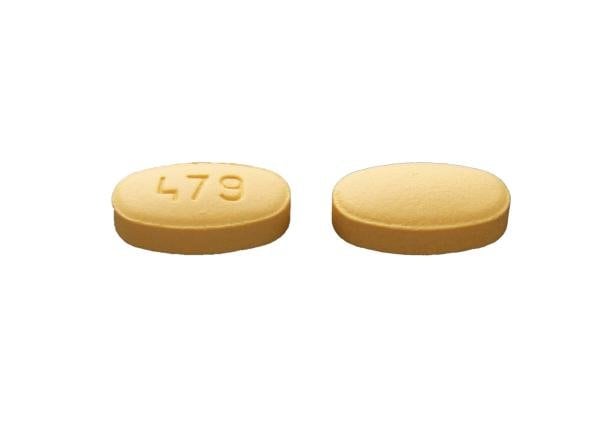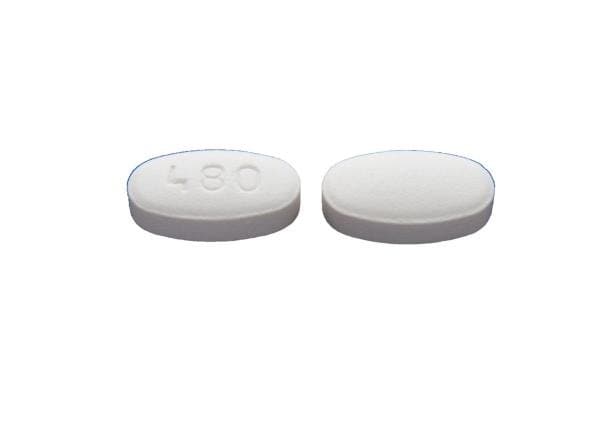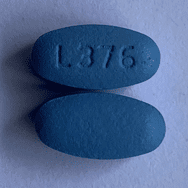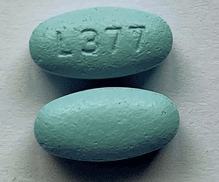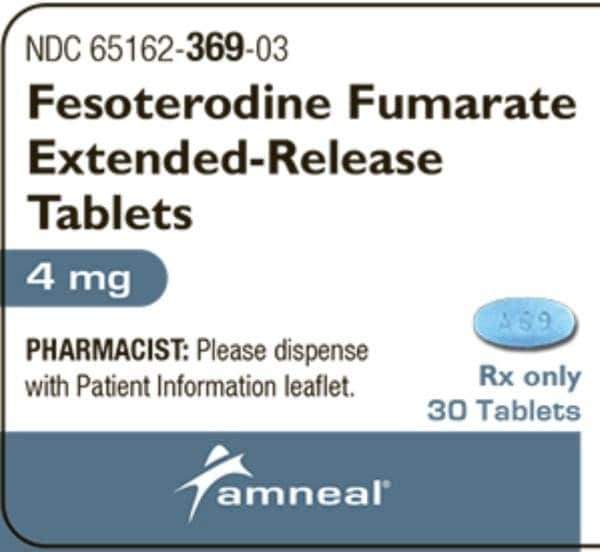Dosage Forms
Excipient information presented when available (limited, particularly for generics); consult specific product labeling.
Tablet Extended Release 24 Hour, Oral, as fumarate:
Toviaz: 4 mg, 8 mg [contains fd&c blue #2 aluminum lake, soybean lecithin]
Pharmacology
Mechanism of Action
Fesoterodine acts as a prodrug and is converted to an active metabolite, 5-hydroxymethyl tolterodine (5-HMT); 5-HMT is responsible for fesoterodine’s antimuscarinic activity and acts as a competitive antagonist of muscarinic receptors.
Urinary bladder contractions are mediated by muscarinic receptors; fesoterodine inhibits the receptors in the bladder preventing symptoms of urgency and frequency.
Pharmacokinetics/Pharmacodynamics
Absorption
Well absorbed
Distribution
IV: 5-HMT: Vd: 169 L
Metabolism
Fesoterodine is rapidly and extensively metabolized to its active metabolite (5-hydroxymethyl tolterodine; 5-HMT) by nonspecific esterases; 5-HMT is further metabolized via CYP2D6 and CYP3A4 to inactive metabolites.
Excretion
Urine (~70%; 16% as 5-HMT, ~53% as inactive metabolites); feces (7%)
Time to Peak
Plasma: 5-HMT: ~5 hours; Cmax higher in poor CYP2D6 metabolizers
Half-Life Elimination
~7 hours
Protein Binding
5-HMT: ~50% (primarily to albumin and alpha1-acid glycoprotein)
Use in Specific Populations
Special Populations: Renal Function Impairment
Plasma concentrations of the active metabolite are increased in patients with renal impairment.
Special Populations: Hepatic Function Impairment
Plasma concentrations of the active metabolite are increased in patients with hepatic impairment.
Use: Labeled Indications
Overactive bladder: Treatment of patients with an overactive bladder with symptoms of urinary frequency, urgency, or urge incontinence.
Contraindications
Hypersensitivity to fesoterodine, tolterodine, or any component of the formulation; urinary retention; gastric retention; uncontrolled narrow-angle glaucoma
Dosage and Administration
Dosing: Adult
Overactive bladder: Oral: 4 mg once daily; may be increased to 8 mg once daily based on individual response and tolerability
Dosing adjustment for concomitant strong CYP3A4 inhibitors (eg, ketoconazole, itraconazole, clarithromycin): Maximum dose: 4 mg once daily
Dosing: Geriatric
Refer to adult dosing.
Administration
May be administered with or without food. Swallow whole; do not chew, crush, or divide.
Storage
Store at 20°C to 25°C (68°F to 77°F); excursions permitted between 15°C to 30°C (59°F to 86°F). Protect from moisture.
Fesoterodine Images
Drug Interactions
Acetylcholinesterase Inhibitors: May diminish the therapeutic effect of Anticholinergic Agents. Anticholinergic Agents may diminish the therapeutic effect of Acetylcholinesterase Inhibitors. Monitor therapy
Aclidinium: May enhance the anticholinergic effect of Anticholinergic Agents. Avoid combination
Alcohol (Ethyl): May enhance the CNS depressant effect of Fesoterodine. Monitor therapy
Amantadine: May enhance the anticholinergic effect of Anticholinergic Agents. Monitor therapy
Anticholinergic Agents: May enhance the adverse/toxic effect of other Anticholinergic Agents. Monitor therapy
Aprepitant: May increase the serum concentration of CYP3A4 Substrates (High risk with Inhibitors). Monitor therapy
Bosentan: May decrease the serum concentration of CYP3A4 Substrates (High risk with Inducers). Monitor therapy
Botulinum Toxin-Containing Products: May enhance the anticholinergic effect of Anticholinergic Agents. Monitor therapy
Cannabinoid-Containing Products: Anticholinergic Agents may enhance the tachycardic effect of Cannabinoid-Containing Products. Exceptions: Cannabidiol. Monitor therapy
Chloral Betaine: May enhance the adverse/toxic effect of Anticholinergic Agents. Monitor therapy
Cimetropium: Anticholinergic Agents may enhance the anticholinergic effect of Cimetropium. Avoid combination
Clofazimine: May increase the serum concentration of CYP3A4 Substrates (High risk with Inhibitors). Monitor therapy
Conivaptan: May increase the serum concentration of CYP3A4 Substrates (High risk with Inhibitors). Avoid combination
CYP2D6 Inhibitors: May increase serum concentrations of the active metabolite(s) of Fesoterodine. Monitor therapy
CYP3A4 Inducers (Moderate): May decrease the serum concentration of CYP3A4 Substrates (High risk with Inducers). Monitor therapy
CYP3A4 Inducers (Strong): May increase the metabolism of CYP3A4 Substrates (High risk with Inducers). Management: Consider an alternative for one of the interacting drugs. Some combinations may be specifically contraindicated. Consult appropriate manufacturer labeling. Consider therapy modification
CYP3A4 Inhibitors (Moderate): May decrease the metabolism of CYP3A4 Substrates (High risk with Inhibitors). Monitor therapy
CYP3A4 Inhibitors (Strong): May increase serum concentrations of the active metabolite(s) of Fesoterodine. Management: Avoid fesoterodine doses greater than 4 mg daily in adult patients who are also receiving strong CYP3A4 inhibitors. Consider therapy modification
Dabrafenib: May decrease the serum concentration of CYP3A4 Substrates (High risk with Inducers). Management: Seek alternatives to the CYP3A4 substrate when possible. If concomitant therapy cannot be avoided, monitor clinical effects of the substrate closely (particularly therapeutic effects). Consider therapy modification
Deferasirox: May decrease the serum concentration of CYP3A4 Substrates (High risk with Inducers). Monitor therapy
Duvelisib: May increase the serum concentration of CYP3A4 Substrates (High risk with Inhibitors). Monitor therapy
Eluxadoline: Anticholinergic Agents may enhance the constipating effect of Eluxadoline. Avoid combination
Enzalutamide: May decrease the serum concentration of CYP3A4 Substrates (High risk with Inducers). Management: Concurrent use of enzalutamide with CYP3A4 substrates that have a narrow therapeutic index should be avoided. Use of enzalutamide and any other CYP3A4 substrate should be performed with caution and close monitoring. Consider therapy modification
Erdafitinib: May decrease the serum concentration of CYP3A4 Substrates (High risk with Inducers). Monitor therapy
Erdafitinib: May increase the serum concentration of CYP3A4 Substrates (High risk with Inhibitors). Monitor therapy
Fosaprepitant: May increase the serum concentration of CYP3A4 Substrates (High risk with Inhibitors). Monitor therapy
Fosnetupitant: May increase the serum concentration of CYP3A4 Substrates (High risk with Inhibitors). Monitor therapy
Fusidic Acid (Systemic): May increase the serum concentration of CYP3A4 Substrates (High risk with Inhibitors). Avoid combination
Gastrointestinal Agents (Prokinetic): Anticholinergic Agents may diminish the therapeutic effect of Gastrointestinal Agents (Prokinetic). Monitor therapy
Glucagon: Anticholinergic Agents may enhance the adverse/toxic effect of Glucagon. Specifically, the risk of gastrointestinal adverse effects may be increased. Monitor therapy
Glycopyrrolate (Oral Inhalation): Anticholinergic Agents may enhance the anticholinergic effect of Glycopyrrolate (Oral Inhalation). Avoid combination
Glycopyrronium (Topical): May enhance the anticholinergic effect of Anticholinergic Agents. Avoid combination
Idelalisib: May increase the serum concentration of CYP3A4 Substrates (High risk with Inhibitors). Avoid combination
Ipratropium (Oral Inhalation): May enhance the anticholinergic effect of Anticholinergic Agents. Avoid combination
Itopride: Anticholinergic Agents may diminish the therapeutic effect of Itopride. Monitor therapy
Ivosidenib: May decrease the serum concentration of CYP3A4 Substrates (High risk with Inducers). Monitor therapy
Larotrectinib: May increase the serum concentration of CYP3A4 Substrates (High risk with Inhibitors). Monitor therapy
Levosulpiride: Anticholinergic Agents may diminish the therapeutic effect of Levosulpiride. Avoid combination
Lorlatinib: May decrease the serum concentration of CYP3A4 Substrates (High risk with Inducers). Management: Avoid concurrent use of lorlatinib with any CYP3A4 substrates for which a minimal decrease in serum concentrations of the CYP3A4 substrate could lead to therapeutic failure and serious clinical consequences. Consider therapy modification
Mianserin: May enhance the anticholinergic effect of Anticholinergic Agents. Monitor therapy
MiFEPRIStone: May increase the serum concentration of CYP3A4 Substrates (High risk with Inhibitors). Management: Minimize doses of CYP3A4 substrates, and monitor for increased concentrations/toxicity, during and 2 weeks following treatment with mifepristone. Avoid cyclosporine, dihydroergotamine, ergotamine, fentanyl, pimozide, quinidine, sirolimus, and tacrolimus. Consider therapy modification
Mirabegron: Anticholinergic Agents may enhance the adverse/toxic effect of Mirabegron. Monitor therapy
Mitotane: May decrease the serum concentration of CYP3A4 Substrates (High risk with Inducers). Management: Doses of CYP3A4 substrates may need to be adjusted substantially when used in patients being treated with mitotane. Consider therapy modification
Netupitant: May increase the serum concentration of CYP3A4 Substrates (High risk with Inhibitors). Monitor therapy
Nitroglycerin: Anticholinergic Agents may decrease the absorption of Nitroglycerin. Specifically, anticholinergic agents may decrease the dissolution of sublingual nitroglycerin tablets, possibly impairing or slowing nitroglycerin absorption. Monitor therapy
Opioid Agonists: Anticholinergic Agents may enhance the adverse/toxic effect of Opioid Agonists. Specifically, the risk for constipation and urinary retention may be increased with this combination. Monitor therapy
Oxatomide: May enhance the anticholinergic effect of Anticholinergic Agents. Avoid combination
Palbociclib: May increase the serum concentration of CYP3A4 Substrates (High risk with Inhibitors). Monitor therapy
Potassium Chloride: Anticholinergic Agents may enhance the ulcerogenic effect of Potassium Chloride. Management: Patients on drugs with substantial anticholinergic effects should avoid using any solid oral dosage form of potassium chloride. Avoid combination
Potassium Citrate: Anticholinergic Agents may enhance the ulcerogenic effect of Potassium Citrate. Avoid combination
Pramlintide: May enhance the anticholinergic effect of Anticholinergic Agents. These effects are specific to the GI tract. Consider therapy modification
Ramosetron: Anticholinergic Agents may enhance the constipating effect of Ramosetron. Monitor therapy
Revefenacin: Anticholinergic Agents may enhance the anticholinergic effect of Revefenacin. Avoid combination
Sarilumab: May decrease the serum concentration of CYP3A4 Substrates (High risk with Inducers). Monitor therapy
Secretin: Anticholinergic Agents may diminish the therapeutic effect of Secretin. Management: Avoid concomitant use of anticholinergic agents and secretin. Discontinue anticholinergic agents at least 5 half-lives prior to administration of secretin. Consider therapy modification
Siltuximab: May decrease the serum concentration of CYP3A4 Substrates (High risk with Inducers). Monitor therapy
Simeprevir: May increase the serum concentration of CYP3A4 Substrates (High risk with Inhibitors). Monitor therapy
Stiripentol: May increase the serum concentration of CYP3A4 Substrates (High risk with Inhibitors). Management: Use of stiripentol with CYP3A4 substrates that are considered to have a narrow therapeutic index should be avoided due to the increased risk for adverse effects and toxicity. Any CYP3A4 substrate used with stiripentol requires closer monitoring. Consider therapy modification
Thiazide and Thiazide-Like Diuretics: Anticholinergic Agents may increase the serum concentration of Thiazide and Thiazide-Like Diuretics. Monitor therapy
Tiotropium: Anticholinergic Agents may enhance the anticholinergic effect of Tiotropium. Avoid combination
Tocilizumab: May decrease the serum concentration of CYP3A4 Substrates (High risk with Inducers). Monitor therapy
Topiramate: Anticholinergic Agents may enhance the adverse/toxic effect of Topiramate. Monitor therapy
Umeclidinium: May enhance the anticholinergic effect of Anticholinergic Agents. Avoid combination
Adverse Reactions
>10%: Gastrointestinal: Xerostomia (19% to 35%; dose-related)
1% to 10%:
Cardiovascular: Peripheral edema (1%)
Central nervous system: Insomnia (1%)
Dermatological: Skin rash (1%)
Endocrine & metabolic: Increased gamma-glutamyl transferase (1%)
Gastrointestinal: Constipation (4% to 6%), dyspepsia (2%), nausea (1% to 2%), abdominal pain (1%)
Genitourinary: Urinary tract infection (3% to 4%), dysuria (1% to 2%), urinary retention (1%)
Hepatic: Increased serum ALT (1%)
Neuromuscular & skeletal: Back pain (1% to 2%)
Ophthalmic: Dry eye syndrome (1% to 4%)
Respiratory: Upper respiratory tract infection (2% to 3%), cough (1% to 2%), dry throat (1% to 2%)
<1%, postmarketing, and/or case reports: Angina pectoris, angioedema, blurred vision, chest pain, diverticulitis, dizziness, drowsiness, facial edema, gastroenteritis, headache, heat exhaustion, hypersensitivity reaction, increased heart rate (dose-related), irritable bowel syndrome, palpitations, prolonged Q-T interval on ECG, pruritus, urticaria
Warnings/Precautions
Concerns related to adverse effects:
- Angioedema: Cases of angioedema involving the face, lips, tongue, and/or larynx have been reported, including after the initial dose. Discontinue immediately if tongue, hypopharynx, or larynx are involved.
- CNS effects: Anticholinergics may cause drowsiness, dizziness, headache, and/or blurred vision, which may impair physical or mental abilities; patients must be cautioned about performing tasks which require mental alertness (eg, operating machinery or driving). Dose reduction or discontinuation should be considered if CNS effects occur.
- Heat prostration: May occur in the presence of increased environmental temperature; use caution in hot weather and/or exercise.
Disease-related concerns:
- Bladder flow obstruction: Use with caution in patients with bladder flow obstruction; may increase the risk of urinary retention.
- Gastrointestinal obstructive disorders: Use with caution in patients with decreased GI motility or gastrointestinal obstructive disorders (ie, pyloric stenosis); may increase the risk of gastric retention.
- Glaucoma: Use with caution in patients with controlled (treated) narrow-angle glaucoma.
- Hepatic impairment: Use is not recommended in patients with severe hepatic impairment; has not been studied.
- Myasthenia gravis: Use with caution in patients with myasthenia gravis.
- Renal impairment: Use with caution in patients with renal impairment. Dose adjustment recommended in patients with severe renal impairment (CrCl <30 mL/minute).
Concurrent drug therapy issues:
- Drug-drug interactions: Potentially significant interactions may exist, requiring dose or frequency adjustment, additional monitoring, and/or selection of alternative therapy. Consult drug interactions database for more detailed information.
Special populations:
- Elderly: Risk of adverse effects may be increased in elderly patients.
Monitoring Parameters
Anticholinergic effects (ie, dry mouth, constipation, dizziness); renal function; hepatic function; postvoid residual (PVR) urine volume and urinary tract infection prior to initiation of therapy (ACOG 2015)
Pregnancy
Pregnancy Considerations
Adverse effects have been observed in some animal reproduction studies.
Patient Education
What is this drug used for?
- It is used to treat an overactive bladder.
Frequently reported side effects of this drug
- Dry mouth
- Constipation
Other side effects of this drug: Talk with your doctor right away if you have any of these signs of:
- Lack of sweat
- Difficult urination
- Blurred vision
- Headache
- Dizziness
- Fatigue
- Signs of a significant reaction like wheezing; chest tightness; fever; itching; bad cough; blue skin color; seizures; or swelling of face, lips, tongue, or throat.
Note: This is not a comprehensive list of all side effects. Talk to your doctor if you have questions.
Consumer Information Use and Disclaimer: This information should not be used to decide whether or not to take this medicine or any other medicine. Only the healthcare provider has the knowledge and training to decide which medicines are right for a specific patient. This information does not endorse any medicine as safe, effective, or approved for treating any patient or health condition. This is only a brief summary of general information about this medicine. It does NOT include all information about the possible uses, directions, warnings, precautions, interactions, adverse effects, or risks that may apply to this medicine. This information is not specific medical advice and does not replace information you receive from the healthcare provider. You must talk with the healthcare provider for complete information about the risks and benefits of using this medicine.
